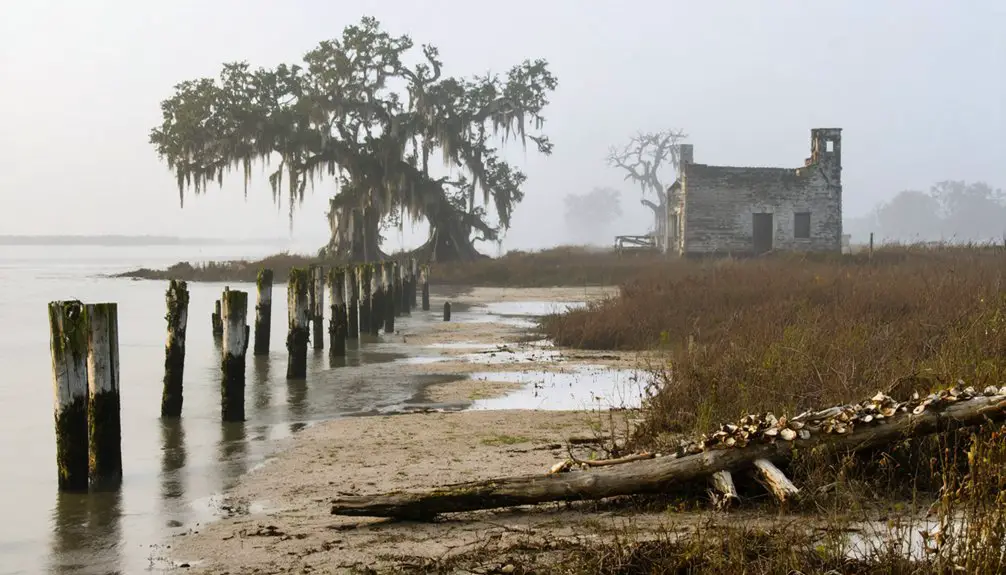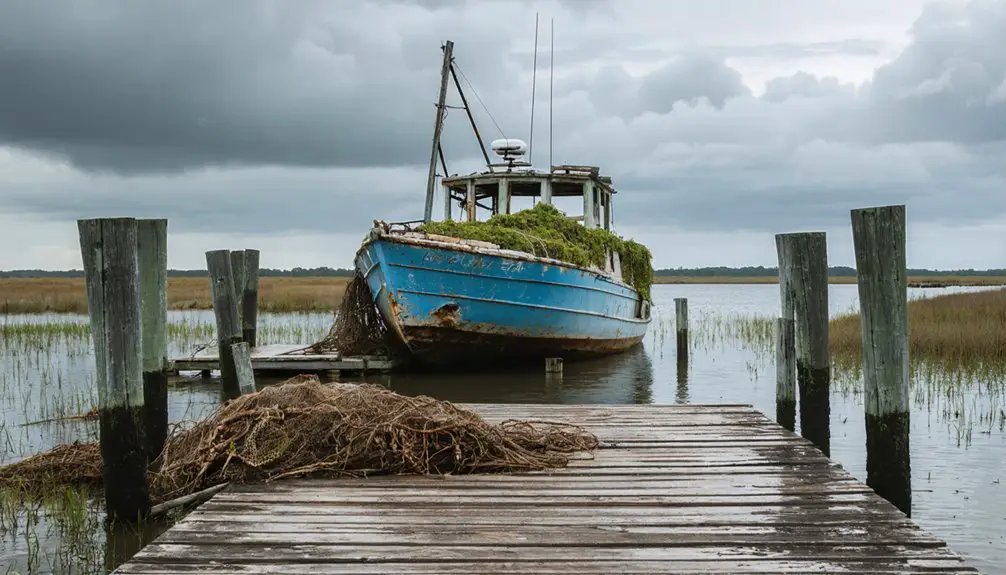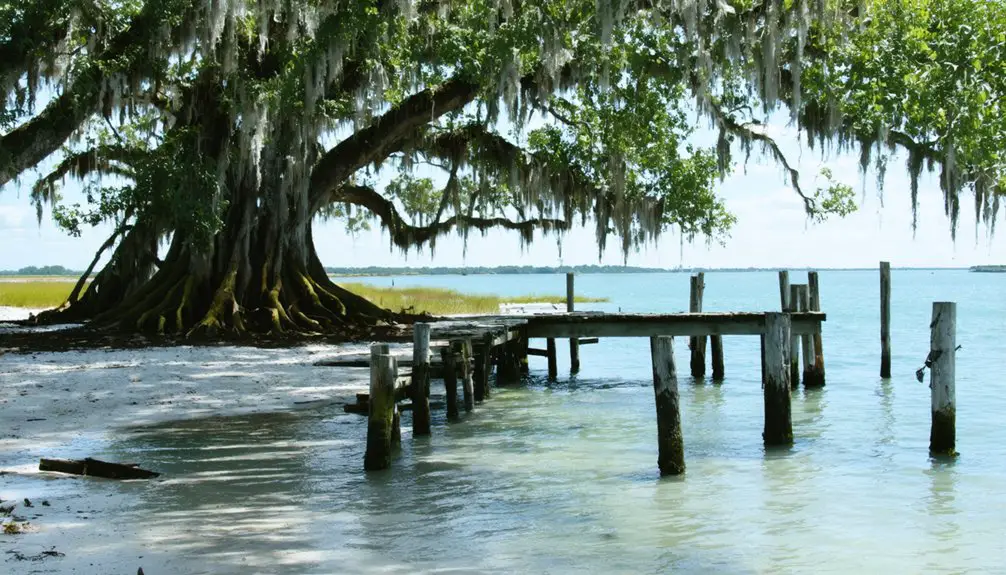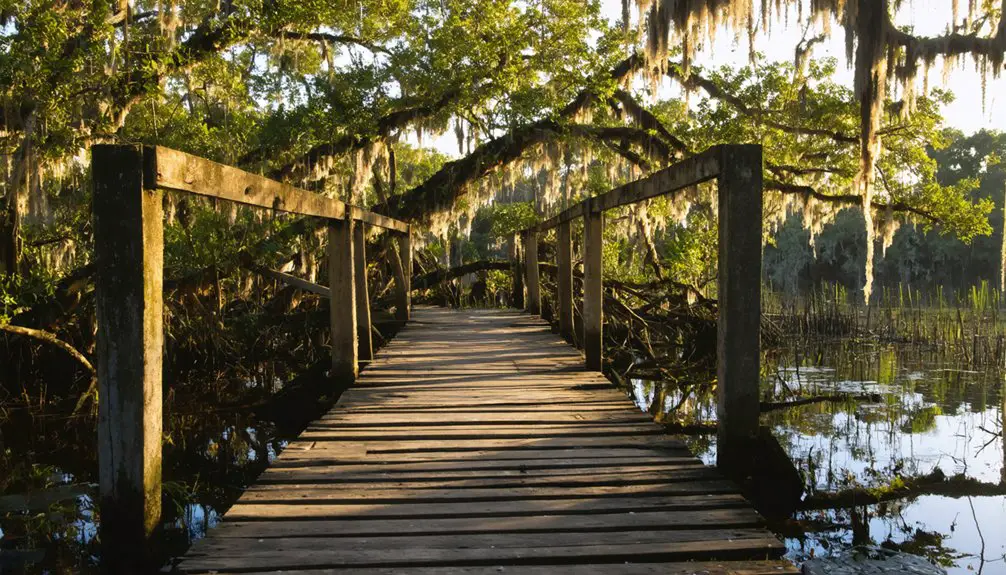You’ll find Bayport’s historic remains along Florida’s Nature Coast, where this once-bustling Confederate port town thrived from 1852 until its decline. Founded by Thomas H. Parsons at the Weeki Wachee River’s mouth, Bayport served as an essential blockade-running port during the Civil War and later flourished through fishing, lumber, and bootlegging operations. The iconic Bayport Hotel stood until 1943, and today’s preserved landscape holds centuries of maritime secrets.
Key Takeaways
- Bayport transformed from a thriving 1850s port town to a ghost town after declining maritime trade and the 1943 hotel fire.
- Once Hernando County’s seat and vital Confederate port, Bayport now consists mainly of historical ruins and natural landscape.
- The destruction of the landmark Bayport Hotel in 1943 marked a symbolic end to the town’s century of prosperity.
- Historical graves in the old cemetery remain hidden by vegetation, serving as remnants of the abandoned settlement.
- Modern Bayport exists primarily as a preserved wetland area, with few traces of its busy maritime and trading past.
The Birth of a Coastal Settlement (1852)
On Florida’s Gulf Coast, Bayport emerged as a promising coastal settlement in 1852 when Thomas H. Parsons purchased land at the mouth of the Weeki Wachee River. You’ll find that his uncle, Major John D. Parsons, soon followed, creating a family-driven foundation for the town’s development.
Despite initial settlement challenges, Bayport’s strategic location quickly attracted attention. By 1853, you could see the settlement’s rapid transformation as Congress designated it both a Port of Entry and Port of Delivery. The town would later become a vital Confederate blockade port during the American Civil War.
The natural confluence of Mud Creek and the Weeki Wachee River provided ideal conditions for shipping, while economic influences from cotton, lumber, and turpentine trades shaped the town’s growth. Within two years, you’d witness Bayport’s rising prominence as it briefly became Hernando County’s seat of government. The town was carefully designed with a central public square to accommodate its growing population.
Early Pioneers and Founding Families
You’ll find traces of Bayport’s earliest settlers in the homesteads that dotted the coastline, where families like the Giddens and Parsons carved out lives through fishing, farming, and operating small businesses.
John D. Parsons’ 1842 military land grant and Thomas H. Parsons’ subsequent 1852 expansion laid the foundation for other pioneering families to establish roots in the area.
The Goethe family’s fishing enterprise, which shipped iced fish by wagon to Centralia’s railroad, and Mrs. Goethe’s hotel operation exemplified how these founding families shaped Bayport’s early economy through resourceful entrepreneurship.
The town experienced rapid development and reached its peak within twenty years of settlement, following the Armed Occupation Act.
Like the Oriole mining company that operated in nearby Hernando County, these early settlers found various ways to make a living from the land’s resources.
Early Settlers’ Daily Life
Life for Bayport’s earliest pioneers revolved around the strategic confluence of the Weeki Wachee River and the Gulf of Mexico, where families like the Parsons, Garrisons, and Jenkinses established their homes in the 1850s.
Your daily pioneer routines would’ve centered on maritime activities, with the port bustling as cotton and agricultural goods moved through the docks. You’d find yourself gathering at key community spots like the Bayport Hotel (formerly John Parsons’ home) and the post office, where news and supplies arrived regularly. Much like the pineapple plantations that defined early Viking, Florida, these pioneers developed their own agricultural identity. The citrus and meat exports through the port helped establish Bayport as a vital trade hub before the Civil War.
Community gatherings strengthened bonds among the frontier families, who relied heavily on river transport rather than rough overland routes. Seasonal changes and coastal weather patterns would’ve dictated your farming schedule, while the town’s Port of Entry status kept you connected to wider markets.
Key Founding Family Legacies
When Major John D. Parsons founded Bayport in 1842, you’d find his military land grant was just the beginning of the Parsons influence that would shape this bustling port town.
Along with his nephew Thomas Henry Parsons, who arrived in 1852, they established extensive trade networks that transformed Bayport into a crucial commercial hub.
The Parsons legacy, anchored by John’s prominent home-turned-hotel, attracted other influential settlers like I. Garrison, John E. Johnson, and C.T. Jenkins. A dedicated disambiguation page helps researchers distinguish this historic Bayport from other locations sharing the same name.
Together, they’d secure Bayport’s designation as a port of entry in 1853 and briefly as the county seat in 1854.
Even through the Civil War‘s disruptions and Union blockades, these founding families adapted, using smaller waterways to maintain commerce.
Their impact lives on in Hernando County’s historic sites and cultural heritage.
Homesteads Along The Coast
Strategically positioned at the mouth of the Weeki Wachee River, Bayport’s earliest homesteads emerged from military land grants awarded to veterans like Major John D. Parsons.
You’ll find that these pioneering families, including the Garrisons, Johnsons, and Jenkins, established their coastal heritage by building homes that doubled as commercial hubs along the natural harbor by 1852.
Thomas H. Parsons’ land purchase in 1852 sparked further homestead development, creating a thriving community where families combined subsistence farming with maritime trade.
These early settlers took advantage of the rich estuarine environment, engaging in fishing and shipping activities. The area became a vital supply port that served neighboring states throughout the 1850s.
While the original structures haven’t survived, the legacy of these homesteads lives on through homestead preservation efforts in what’s now mostly public parkland and water management areas.
Today, visitors can explore the historic Bayport Cemetery on foot, where many of these founding families were laid to rest.
The Legendary Bayport Hotel
You’ll find the Bayport Hotel‘s most intriguing chapter began in 1842 when Thomas Henry Parsons constructed what would become one of Florida’s Gulf Coast’s most storied establishments.
During the Civil War, you’d notice the hotel’s strategic position made it an ideal spot for Confederate smuggling operations, while still maintaining its reputation for quality accommodations and dining for legitimate travelers.
The hotel’s dual identity as both a respectable establishment and a covert operational base continued until its destruction by fire in 1943, marking the end of a century of secrets and hospitality. Like the original 1919 building that would later become Bay Port Inn, the Bayport Hotel stood as a testament to Florida’s rich hospitality heritage.
Historic Accommodations and Dining
Founded in 1842 amid Florida’s Armed Occupation Act, the Bayport Hotel emerged from the colonial home of John Parsons, who acquired the property in 1852.
After his death in 1888, the residence transformed into a premier destination for coastal hospitality, serving both travelers and sporting enthusiasts seeking adventure along Florida’s Gulf Coast.
Under Frances Goethe’s management after 1909, you’d have found yourself enjoying renowned family-style dining while mingling with fellow anglers and boaters.
The hotel’s historic dining experience drew visitors from far and wide, complemented by a small store that, during Prohibition, discretely stored liquor for underground trade.
You could’ve witnessed the bustling commercial fishing operation run by Goethe and her son Henry, shipping iced fish to markets across America until fire claimed the structure in the early 1940s.
Smuggling and Secret Operations
Beyond its reputation as a coastal retreat, the Bayport Hotel harbored a complex web of bootlegging operations during Prohibition. Under the management of “Ole Miss” and the Goethe family, the hotel served as a crucial hub in secret networks connecting Cuba to Tampa.
You’d find liquor cleverly disguised in “hams” – burlap-wrapped packages arriving via coastal barges, while the hotel’s fishing business provided perfect cover for the illicit trade.
- Fearless fishermen earned $2 per case to move contraband under cover of darkness
- Local smuggling networks operated with precision, using forged manifests and corrupt officials
- A mysterious Cuban enforcer once checked in, leading to a murder that silenced informants
- The Coast Guard’s capture of the Sadell in 1931 revealed the scale of operations: $40,000 in seized liquor

During the Civil War, Bayport emerged as an essential Confederate blockade-running hub after Union forces seized control of larger southern ports.
You’d find Confederate blockade runners exploiting Bayport’s shallow waters and rocky seafloor to evade the Union’s East Gulf Blockading Squadron. The harbor’s unique geography near the Weeki Wachee River created perfect conditions for clandestine operations, while nearby plantations supplied crucial commodities like cotton, salt, and beef.
Union naval tactics evolved to counter these operations, with ships like the St. Lawrence launching small boat expeditions to navigate the treacherous waters.
Confederate defenders countered by removing channel markers and constructing a two-gun battery north of the fishing pier, where sharpshooters helped protect their supply routes to Cuba.
Despite the Union’s capture of eleven blockade runners, Bayport’s strategic role persisted throughout the war.
The Battle of Bayport (1863)
As tensions escalated along Florida’s Gulf Coast in early 1863, a significant naval engagement unfolded at Bayport on April 3rd when Union forces launched an ambitious pre-dawn raid.
Acting Lieutenant Edward McCauley led seven small boats against this crucial Confederate logistics hub, targeting blockade runners who’d been successfully exploiting Bayport’s shallow harbor.
Despite rough seas delaying their approach, Union forces pressed forward but met fierce resistance from Confederate defenses, including rifle pits and artillery positions along the shoreline.
- You can still hear echoes of the Confederate riflemen’s deadly accurate fire from their strategic positions.
- You’ll feel the desperation as Confederate forces burned their own cotton-laden schooner to prevent capture.
- You might sense the frustration of Union sailors as their guns failed during the assault.
- You can imagine the relief of local residents as Confederate forces maintained control of their crucial port.
Commercial Fishing and Maritime Trade

Once Congress designated Bayport as an official Port of Delivery and Port of Entry in 1853, the town’s maritime economy flourished through a combination of commercial fishing and strategic trade.
You’d have seen local fishermen, including skilled African-American crews, employing various fishing techniques from gill-nets to haul-seines, targeting mullet, shad, and alewives.
The Parsons family played a key role in expanding the maritime infrastructure, developing docks and processing facilities along artificial peninsulas near the Weeki Wachee River mouth.
During the Civil War, Bayport’s significance grew as larger ports faced blockades.
Later, technological advances like motorized boats and refrigeration revolutionized the industry, though by the early 1900s, overfishing had severely depleted the once-abundant mullet and shad populations.
Tales of Smuggling and Mystery
While Bayport’s maritime economy centered on fishing and trade, the town harbored a darker side during Prohibition. You’d find smuggling techniques that included packaging liquor in “hams” – six bottles sewn in burlap – and moving contraband through the community’s network of caves and cellars.
Community involvement ran deep, with local fishermen coordinating signals to Cuban boats and disguising shipments in peanut trucks heading inland.
Resourceful locals masked their bootlegging operations through clever signals and everyday shipping methods, turning fishermen into secret allies of Cuban smugglers.
- The mysterious burning of Bayport’s hotel in 1942 still sparks whispered conversations
- A Cuban assassin silenced a federal informant before vanishing on a rum boat
- Local families protected smuggling secrets, viewing it as their economic lifeline
- The Coast Guard’s capture of the Sadell, loaded with $40,000 in liquor, became legendary, though her crew slipped away into the night
Natural Landscape and Geographic Features

Beyond the shadowy tales of smuggling, Bayport’s natural landscape tells its own compelling story. You’ll find this coastal haven where the Weeki-Wachee River meets Mud Creek before emptying into the Gulf of Mexico.
Dense marshes and pristine wetlands stretch as far as you can see, showcasing Florida’s untamed beauty. The marsh ecology thrives in this protected sanctuary, where tidal flows shape the shoreline and natural filtration systems support countless species.
You can explore Pine Island’s wilderness via the bayou road, or launch your boat from the public ramp to discover hidden waterways. Since 2000, coastal preservation efforts have secured much of Bayport’s original land, ensuring these waters and woodlands remain wild and free.
Even the old cemetery has surrendered to nature’s reclamation, with native vegetation concealing its 19th-century graves.
From Bustling Port to Historic Park
After Thomas H. Parsons established Bayport in 1852, you’d have witnessed its rapid transformation into a thriving port town.
The area’s cultural significance peaked when Congress designated it as a Port of Entry in 1853, making it Hernando County’s gateway for lumber and agricultural exports.
- You can still find remnants of Confederate cannon batteries near today’s fishing pier, echoing the town’s role in the Civil War.
- Walking through modern Bayport Park, you’re treading where blockade runners once dashed through Union naval blockades.
- The environmental impact of preserving 2,100 acres of undeveloped land has protected the coastal beauty that first attracted settlers.
- Standing at the rebuilt marina, you’ll experience the same deep Gulf access that made this port strategically valuable.
The town’s commercial decline began in 1885 when railroads reached Brooksville, but SWFMD’s preservation efforts have maintained its historic essence.
Frequently Asked Questions
How Many People Lived in Bayport During Its Peak Population Years?
While exact ghost town demographics weren’t recorded, historical population trends suggest you’d find several hundred to perhaps a thousand residents during Bayport’s bustling peak as a Civil War-era port town.
What Happened to the Original Buildings and Structures After the Town’s Decline?
Like a ghost in the machine, you’d find most abandoned structures succumbed to fires, floods, and decay. By 2000, without historical preservation efforts, nearly everything vanished except a few early 1900s homes.
Are There Any Remaining Artifacts From Bayport’s Smuggling Era on Display?
You’ll find limited smuggling history artifacts exhibited through Nicole Tumbleson’s archaeological discoveries, including Confederate blockade-running items and “hard money” found in the harbor, but no major public displays exist.
Did Any Famous Historical Figures Ever Visit or Stay in Bayport?
Lost to time’s shadows, you won’t find evidence of famous visitors in historical records. Despite Bayport’s significance during the Civil War, no documentation confirms any notable historical figures stayed there.
What Native American Tribes Inhabited the Bayport Area Before Settlement?
You’ll find Paleo-Indians first inhabited the area 13,000 years ago, followed by Deptford, Weeden Island, and Safety Harbor cultures. Later, Seminole influence grew as they migrated from Creek territories.
References
- https://www.fivay.org/bayport.html
- https://www.exploresouthernhistory.com/bayportbattle.html
- https://www.ghosttowns.com/states/fl/bayport.html
- https://cccourthouse.org/wp-content/uploads/2023/12/Ghost-towns-and-Cemeteries-of-Citrus-County.pdf
- https://floridatraveler.org/2017/04/25/floridas-unique-ghost-towns-are-not-invisible/
- https://gulfarchaeology.org/historical-archaeology/
- https://naturecoaster.com/communities/bayport-and-pine-island/
- https://www.fivay.org/hernando1.html
- https://www.youtube.com/watch?v=gfgs5nYmpBM
- https://floridatrailblazer.com/category/ghost-towns/page/2/



